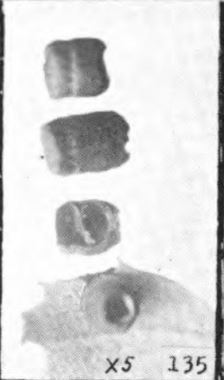Phylloteras cupella (agamic)
Trigonaspis cupella, new species
Host. — Quercus grisea, undulata, arizonica.
Gall (fig. 39). — A small black cup-shaped spangle scattered on upper and under surface of leaf in the fall and dropping with the leaf. From one to a dozen on a leaf. Galls measure up to 2.6 mm. in diameter and 2 mm. high, the exit hole in the shallow cup at apex, the mouth of the cup xometimes slightly constricted by the inrolled edges of the thick wall, the larval cell lying transversely at base of gall.
Habitat. — The type is selected from material on Quercus grisea from Magdalena, N. Mex., where the galls were very common in November 1921. Paratypes are from galls on Q. undulata at Tijeras in the Sandia Mountains. Flies emerged from both lots of galls from January 24 to February 6, 1922. Other paratypes are from Q. arizonica from the Mule mountains and from Oracle in the Santa Catalina Mountains, Ariz. Galls were observed on these hosts at Nogai Canyon south of Socorro, Hillsboro, Kingston, and in Burro mountains, N. Mex., and at Prescott, Ariz. Similar galls were observed on Q. oblongifolia in the Hiuichuca and Patagonia Mountains.
”- LH Weld: (1926) Field notes on gall-inhabiting cynipid wasps with descriptions of new species©
Reference: https://www.biodiversitylibrary.org/page/7610635#page/318/mode/1up








